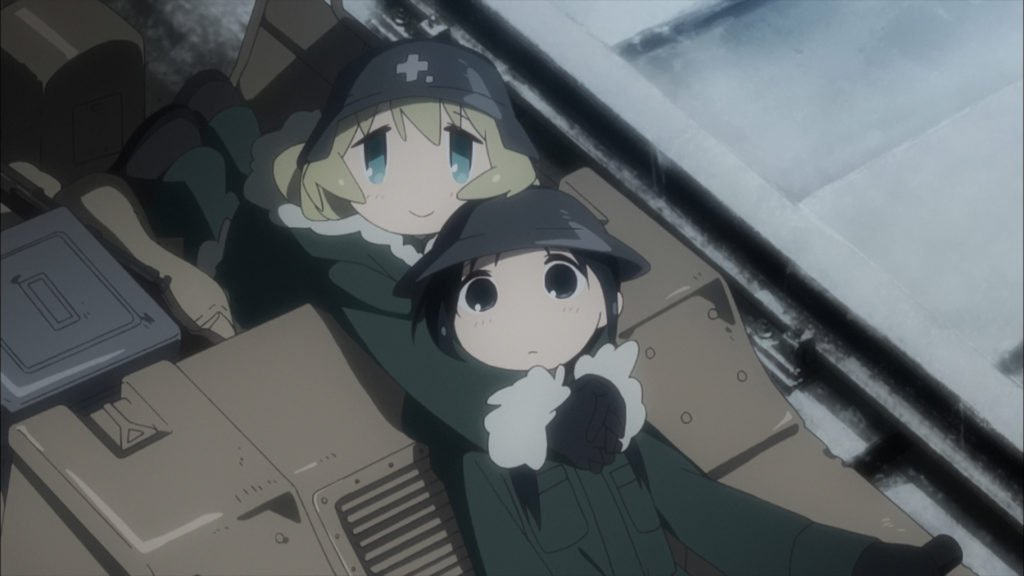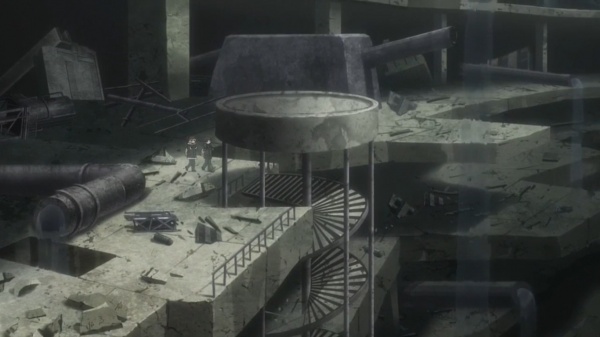








In 2009, there was a Japanese video game called "Fragile" that released for the Nintendo Wii. Ever since I read a preview, saw the screenshots, and watched the trailer and heard its music, I was captivated. The game was about a lone protagonist, a young man, the only human left after the human race has mysteriously vanished from modern-day Japan. It's a game about exploration, wandering the ruins of the abandoned cities, factories, subway stations and amusement parks. The story involves discovering a single other soul, and chasing to find them again, while passively learning more about the lost world. It wasn't a 'great' game, per say, but it left enough of an impact to be among my top five games for the system. I haven't seen anything like it in games or other media, and desparately crave it.The reason I bring up such a bizarrely obscure thing is because of this review: 2017 anime "Girls' Last Tour." It's easy to confuse with "Made in Abyss," another 2017 anime about exploration, featuring a team of two characters, one of which has blond hair, and both with distinct anime designs that utilize large round heads. It actually has a lot more in common with anime like "Kino's Journey." Set in some unspecified future, Chi and Yu are two young women that ride together in a motorized caravan across an abandoned wasteland of snow and concrete, full of large cities that haven't seen human civilization in centuries. It's technically a "cute-girls-doing-cute-things, slice-of-life" type of show, but with the extra context of mystery and wonder. It reminded me a lot of "Fragile," and being such a fan of that, I turned out to be a big fan of "Girls' Last Tour." Another factor is that I didn't get around to watching it until early 2020, when the global "novel coronavirus" pandemic covered the planet. Like millions of others, I worked from home, enjoying my solitude and binging on games and anime, while quietly expecting the apocolypse at any moment. In that state of mind, "Girls' Last Tour" feels especially relevant, and the sweet peacefulness of it is like a ray of sunshine in a days-long rainstorm. It doesn't put my mind at ease that the world won't end anytime soon, but it makes me think that an interesting life of discovery could still exist beyond that.The premise of "Girls' Last Tour" probably doesn't sound all that exciting to the average viewer. Especially when I say that there aren't many answers about the world these girls explore after the 12 episodes are over. But consider again the simplified genre category: "cute-girls-doing-cute-things, slice-of-life, comedy, with dark looming context." If you like anime girls being cute and funny, you'll still be certain to enjoy "Girls' Last Tour," a show that surpasses the typical expectations the genre comes with.Each episode of the show follows Chi, the smart, serious one, and Yu, the easy-going one that can wield a rifle. The age of the girls is undefined: from their appearance, they could be anywhere between 10 and 30. Each episode has one or two adventures, typically of them discovering a new environment or tackling a problem. These range from traversing through a massive maze of a city, discovering hot water for a bath, clean water for drinking or laundry, or an old battleground with leftover rations for food. Hints about the world suggest a large war took place, and that the current world takes place anywhere from decades to millenia after modern-day. Other hints tell us that Chi and Yu "lived with their grandfather" before setting off on their journey, and that Yu is illiterate, and that they haven't seen things like the sea, or fish. Like any serious travelers, they have to be careful to make their supplies last many days, and to take advantage of food or fuel when they find it. Occassionally, they find another lone human: they aren't alone in the world, but the people they come across seem just as curious about the world's history as they are, and are happy to part ways on their separate journeys. While the show could be labeled a mystery, you might be disappointed to how little information is discovered; most of the dialogue is conjecture about the observations around them. I didn't mind that too much, fully satisfied with the world-building provided. The full history between Chi and Yu also isn't fully explored, sometimes to its advantage: we don't know how long they've been traveling, and a scene or two in each episode suggests tension between these best friends, due to incompatibility or being together in close proximinity for so long. Yu in particular feels a little unpredictable in ways that keep me on edge, if only because she might burn a rare book to keep warm without realizing what she's done. All that backstory DOES eventually get addressed in the final episode, but in an intentionally vague and open-ended way, to let you come to your own conclusions. Dedicated fans might be annoyed at the lack of detail, and I was annoyed that they attempted to dump any information at all (although that last episode also gets the most bizarre bit of world-building, involving a race of alien-like cats...). So the series is mostly a collection of philosophical discussions about why humans had war, why they had God, or why they built cities th way they did, broken up with Chi whacking Yu for laziness or stupidity, or the both of them relaxing their mashmallow heads during a moment of peace from the cold outside. It's calming and soothing, but mildly intellectual too, with a sense of wonder encouraging me to keep watching. Like watching a pair of children seeing the Earth and remnents of the human race for the first time, pondering their meaning, in a simplified but refreshing way.Production values from Studio White Fox are mixed. Animation is as simple as it needs to be, but never feels cheap. The character designs rely in big eyes and heads, sometimes morphing for the sake of humor (my previous description of "marshmallow head" is very accurate here). It's overwhelmingly cute at times, despite when the characters hit each other on the head. The environment designs are more interesting and stylistic, even if they rely on a color palette of grey, brown and blue too often, and even if they don't seem too varied despite the detail. The English dub is simply ok, and I did get used to it, ultimately enjoying it. But early on, I switched often to the original Japanese dub, which feels more appropriate for delivering the soft and somber dialogue for these two leads. What did impress me about the production was the music. For a show like "Girls' Last Tour," soft piano and choir hymns are perfect, and it's emotionally beautiful, enough so to be enjoyed outside the show, and among my favorite background soundtracks in anime from that decade. And the opening and ending themes are chirpy and high-spirited, with wonderful experimental animation! They represent the sense of travel and cuteness well, even if they don't really represent the more somber overtones that best summarize the show. But I never skipped them, not once.I'm surprised with how much I enjoyed "Girls' Last Tour." Even though certain aspects of production were barely above average, and even though the story can frustrate just as much as keep you invested. But there are so few shows, games or media like this, and I'm happy to have discovered it. And since the original manga is relatively short (and has one final volume not covered in the anime), there's plenty of incentive to explore further.
While the show could be labeled a mystery, you might be disappointed to how little information is discovered; most of the dialogue is conjecture about the observations around them. I didn't mind that too much, fully satisfied with the world-building provided. The full history between Chi and Yu also isn't fully explored, sometimes to its advantage: we don't know how long they've been traveling, and a scene or two in each episode suggests tension between these best friends, due to incompatibility or being together in close proximinity for so long. Yu in particular feels a little unpredictable in ways that keep me on edge, if only because she might burn a rare book to keep warm without realizing what she's done. All that backstory DOES eventually get addressed in the final episode, but in an intentionally vague and open-ended way, to let you come to your own conclusions. Dedicated fans might be annoyed at the lack of detail, and I was annoyed that they attempted to dump any information at all (although that last episode also gets the most bizarre bit of world-building, involving a race of alien-like cats...). So the series is mostly a collection of philosophical discussions about why humans had war, why they had God, or why they built cities th way they did, broken up with Chi whacking Yu for laziness or stupidity, or the both of them relaxing their mashmallow heads during a moment of peace from the cold outside. It's calming and soothing, but mildly intellectual too, with a sense of wonder encouraging me to keep watching. Like watching a pair of children seeing the Earth and remnents of the human race for the first time, pondering their meaning, in a simplified but refreshing way.Production values from Studio White Fox are mixed. Animation is as simple as it needs to be, but never feels cheap. The character designs rely in big eyes and heads, sometimes morphing for the sake of humor (my previous description of "marshmallow head" is very accurate here). It's overwhelmingly cute at times, despite when the characters hit each other on the head. The environment designs are more interesting and stylistic, even if they rely on a color palette of grey, brown and blue too often, and even if they don't seem too varied despite the detail. The English dub is simply ok, and I did get used to it, ultimately enjoying it. But early on, I switched often to the original Japanese dub, which feels more appropriate for delivering the soft and somber dialogue for these two leads. What did impress me about the production was the music. For a show like "Girls' Last Tour," soft piano and choir hymns are perfect, and it's emotionally beautiful, enough so to be enjoyed outside the show, and among my favorite background soundtracks in anime from that decade. And the opening and ending themes are chirpy and high-spirited, with wonderful experimental animation! They represent the sense of travel and cuteness well, even if they don't really represent the more somber overtones that best summarize the show. But I never skipped them, not once.I'm surprised with how much I enjoyed "Girls' Last Tour." Even though certain aspects of production were barely above average, and even though the story can frustrate just as much as keep you invested. But there are so few shows, games or media like this, and I'm happy to have discovered it. And since the original manga is relatively short (and has one final volume not covered in the anime), there's plenty of incentive to explore further.